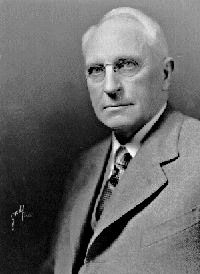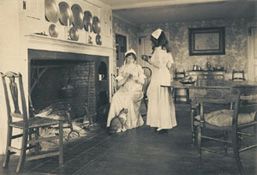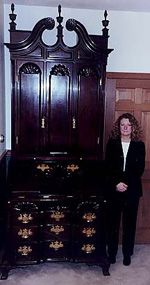
>
 If not for one man, lots of today's woodworkers wouldn't make reproduction furniture. Except for him, lots of us wouldn't have our sense of early American style and of value - our aesthetic. Except for him, our houses and rooms wouldn't look as they do. Yet few can name him. Who was he? He was Wallace Nutting - minister, mental patient, entrepreneur, artist, style-setter and tycoon. He once wrote "Whatever is new is bad." We copy his furniture, built on that principle, in our workshops today.
If not for one man, lots of today's woodworkers wouldn't make reproduction furniture. Except for him, lots of us wouldn't have our sense of early American style and of value - our aesthetic. Except for him, our houses and rooms wouldn't look as they do. Yet few can name him. Who was he? He was Wallace Nutting - minister, mental patient, entrepreneur, artist, style-setter and tycoon. He once wrote "Whatever is new is bad." We copy his furniture, built on that principle, in our workshops today.
His is the story of an overstressed Protestant pastor turned amateur photographer turned pioneering publicist and businessman.
Born in Massachusetts in 1861, young Wallace lost his father in the Civil War. His education gave him a flawless Congregational Church pedigree - Phillips Exeter Academy, Harvard College, Hartford and Union Seminaries. Ordained a Congregational pastor, he served churches in Seattle, Minneapolis, Newark and Providence. We can guess he was a conscientious minister and an overachiever. In 1904 he suffered a nervous breakdown - what doctors of the day called "neurasthenia." Today we call it "burnout."
 One physician suggested photography for relaxation. Nutting brought his work (or overwork) ethic to the camera. He began taking pictures of tranquil New England landscapes and what he called "colonial interiors," and by 1905 he'd hired a team of women to hand-color the photos for sale, copyrighting them with the Library of Congress. In ten years he made over 15,000 negatives and offered 1,000 prints for sale in a catalog. Even now he is known more for pictures than furniture. But his wooden furniture is our interest.
One physician suggested photography for relaxation. Nutting brought his work (or overwork) ethic to the camera. He began taking pictures of tranquil New England landscapes and what he called "colonial interiors," and by 1905 he'd hired a team of women to hand-color the photos for sale, copyrighting them with the Library of Congress. In ten years he made over 15,000 negatives and offered 1,000 prints for sale in a catalog. Even now he is known more for pictures than furniture. But his wooden furniture is our interest.
 He moved to a bigger house. He started buying 17th and 18th century American antiques, beginning with Windsor chairs. His collection soon excelled. By 1912 he was buying and furnishing old houses as sets for his pictures, complete with interpreters dressed in his version of period costumes, and selling admission to the public. These became the "Wallace Nutting Chain of Colonial Picture Houses" - one of the first efforts to successfully commercialize American antiquities. His corporation was named Old America, Incorporated.
He moved to a bigger house. He started buying 17th and 18th century American antiques, beginning with Windsor chairs. His collection soon excelled. By 1912 he was buying and furnishing old houses as sets for his pictures, complete with interpreters dressed in his version of period costumes, and selling admission to the public. These became the "Wallace Nutting Chain of Colonial Picture Houses" - one of the first efforts to successfully commercialize American antiquities. His corporation was named Old America, Incorporated.
 In 1917 Nutting built a furniture factory in an old mill next to his Massachusetts house. He applied modern production methods to what he considered authentic designs, using standardized stock dimensions but applying hand work by turners, carvers and joiners. He was pioneering what modern marketers call "cross promotion." He said "those who know the pictures want the chairs," and he was right - his chairs, chests, cabinets and household items were snapped up by the public. Nutting considered this "honest" furniture, work that reflected the ideal designs and genuine workmanship of decent, moral Americans. The link between his furniture and what we call "civil religion" lay just beneath the surface. When he copied a 17th century chest in oak by Joshua Parmenter, and later a chest-on-chest by John Townsend in mahogany, he felt he was creating objects of nearly sacramental significance.
In 1917 Nutting built a furniture factory in an old mill next to his Massachusetts house. He applied modern production methods to what he considered authentic designs, using standardized stock dimensions but applying hand work by turners, carvers and joiners. He was pioneering what modern marketers call "cross promotion." He said "those who know the pictures want the chairs," and he was right - his chairs, chests, cabinets and household items were snapped up by the public. Nutting considered this "honest" furniture, work that reflected the ideal designs and genuine workmanship of decent, moral Americans. The link between his furniture and what we call "civil religion" lay just beneath the surface. When he copied a 17th century chest in oak by Joshua Parmenter, and later a chest-on-chest by John Townsend in mahogany, he felt he was creating objects of nearly sacramental significance.
 He furnished and decorated five Picture Houses to fit his notion of Old America, sometimes with little proof of authenticity. But Nutting's vision shaped American values and tastes. Simply look at home construction today to find "colonial" features copied from his designs.
He furnished and decorated five Picture Houses to fit his notion of Old America, sometimes with little proof of authenticity. But Nutting's vision shaped American values and tastes. Simply look at home construction today to find "colonial" features copied from his designs.
Nutting's woodworking life coincided neatly with the birth of modern marketing. The Theory of Advertising by Walter Dill Scott appeared in 1903. Fred Clark wrote Principles of Marketing in 1922. Wallace Nutting was a model entrepreneur and promoter.
He published Furniture of the Pilgrim Century in 1924, then the three-volume Furniture Treasury in 1928. His America the Beautiful series included books on all the original colonial states: Pennsylvania Beautiful , Connecticut Beautiful , and so on. Together these books and Nutting's pictures literally created our sense of what early American furniture, houses and landscapes were like. And his influence was soon to spread south.
In 1926 the Rev. Dr. W.A.R. Goodwin, rector of Bruton Parish Church in Williamsburg, Virginia, spoke to John D. Rockefeller, Jr. at a Phi Beta Kappa dinner. Goodwin had struck out selling his idea to Henry Ford, a fact he may not have mentioned to Rockefeller. Would Mr. Rockefeller be willing to back the restoration of Williamsburg as a complete colonial town, including Bruton Parish Church, several houses and public buildings?
No doubt Rockefeller knew all about Wallace Nutting's commercial success in New England. Here was a chance to duplicate and surpass it in Virginia with an entire town. It was almost a religious campaign - Goodwin said they would "reproduce the symbols and sacraments of the past."
All history is revisionist, and Colonial Williamsburg reinterpreted American and Virginia history in settings top-heavy with English furniture and a little French influence – after all, the French had helped us win independence so they deserved a little notice.
In 1925 Wallace Nutting sold his furniture collection to J. Pierpont Morgan, Jr., who donated it to the Wadsworth Athenaeum in Hartford; it claims the most important collection of "Pilgrim Century" furniture in the nation. World War I and later the Depression injured his business terribly, and he died in 1941 although the company lasted four more years. His tools and plans went to Berea College in Kentucky. His factory's furniture, especially from the early production, remains valuable. His vision of Old America, with its sense of beauty, its proportions, its English roots and "honest" values, is very much alive in our woodworking.
 In his 1930 catalog, Nutting was correct in writing, "Shrewd business men have told me that pieces bearing my name will soon be coveted by collectors," for today his works are indeed highly sought after. A Nutting mahogany Goddard block front chest sold at auction for $18,700 in March 2005. It was the third highest price ever paid for a piece of Nutting furniture. The others were a highboy that sold for $33,000 and a Goddard desk secretary, shown on the right, that sold for for $36,750.
In his 1930 catalog, Nutting was correct in writing, "Shrewd business men have told me that pieces bearing my name will soon be coveted by collectors," for today his works are indeed highly sought after. A Nutting mahogany Goddard block front chest sold at auction for $18,700 in March 2005. It was the third highest price ever paid for a piece of Nutting furniture. The others were a highboy that sold for $33,000 and a Goddard desk secretary, shown on the right, that sold for for $36,750.
The Ten Construction Commandments of Wallace Nutting Furniture Construction.
Nutting, ever the minister, developed and gave these to his workers in 1925.
To Insure Individuality and Make Men While Making Furniture.